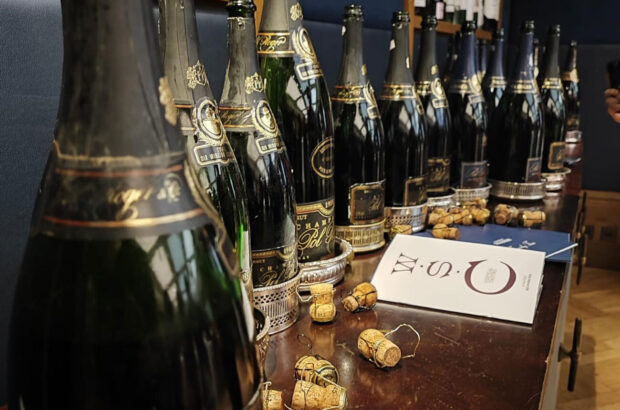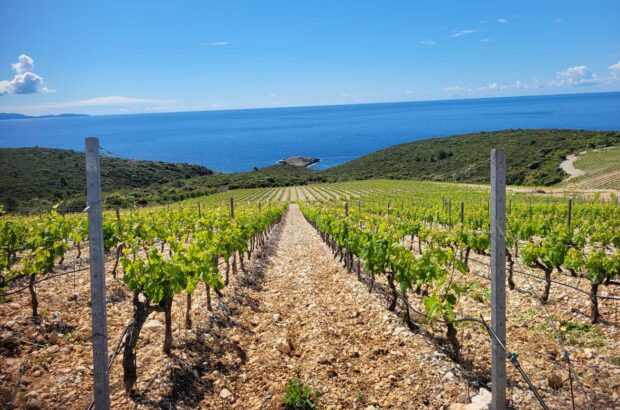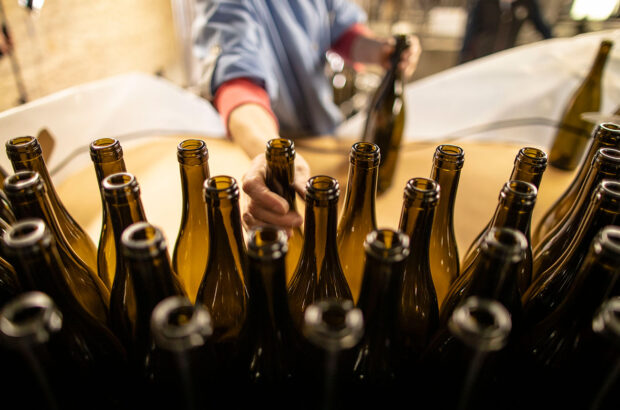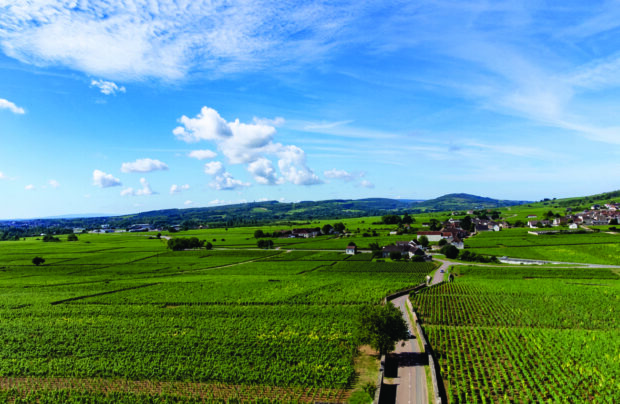Vosne-Romanée offers just the right conditions for Pinot Noir to produce the greatest wines in Burgundy. CLIVE COATES MW provides a guide to the leading growers.
Vosne-Romanée offers just the right conditions for Pinot Noir to produce the greatest wines in Burgundy. CLIVE COATES MW provides a guide to the leading growers.
- The consumer can hardly go wrong.
- Superlative wines, undeniably expensive, rare and highly prized.
- Classification – Grands crus and premiers crus.
- The leading growers.
Vosne-Romanée is the greatest Pinot Noir village on earth. Here this marvellous grape produces wine to its optimum capacity: rich, austere, masculine, aristocratic and sensual. The wines of Chambolle-Musigny are more fragrant, Nuits-Saint-Georges a little more robust and Gevrey-Chambertin more aromatic, but the Vosne-Romanées are the best and they can keep for decades. With six grands crus – eight if you include the two Echézeaux – and 13 fine and distinct premiers crus, the commune is rich in top quality land. What is equally as important is that Vosne-Romanée today contains a very large number of estates, ranging from the large and majestic to the discreet and modest, which produce excellent wine. Some are long-established, others have only begun to bottle seriously in the last decade or so. But now, given a fine vintage (and Burgundy has produced nothing less than good in the 13 years since 1984) the consumer can hardly go wrong.
Vosne-Romanée lies between the walled vineyard of the Clos de Vougeot and the commune of Nuits-Saint-Georges. It is a modest, unassuming village, set away from the main road, with an impressive mairie at one end and the Château de Vosne-Romanée at the other. On three sides little roads wander up into the vineyards, on the fourth they lead down to the Nuits-Dijon highway. But in Vosne itself all is quiet. There is a church but no bar, a post office but no village shop. Other villages are more attractive, and more imposing.
The village marks the position on the slope where village land gains premier or grand cru status. Up above the incline becomes steeper, the exposition more favourable, the drainage more efficient, until at the top of the slope the vines are a little too exposed, the microclimate a little too cool and one is in the land of village wine once again. Below the village the land is too flat, not as well drained, and there are too many clay and alluvial deposits in the soil for the wines of the greatest distinction. Beyond, across the main road, the territory is merely Bourgogne rouge, not even village AC. At roughly 250–285m above sea level, in a narrow band perhaps 300m wide, everything falls into place perfectly, and the combination of limestone soil and Pinot Noir produces the greatest wines in Burgundy.
Classification
Curiously, for single-ownership is rare in Burgundy, four of Vosne-Romanée’s eight grands crus are monopolies, the only ones to be so. The grands crus are Echézeaux, Grands-Echézeaux, La Grande Rue, La Romanée-Saint-Vivant, Richebourg, La Tâche, La Romanée and La Romanée-Conti.The total area of the grands crus is 75 hectares (ha), producing an average of 22,400 hectolitres (hl) (300,000 bottles) per year. Of this, Echézeaux provides over half. In addition to the grands crus there are 13 premiers crus in Vosne-Romanée, totalling 58ha and producing around 2,400hl (316,800 bottles) per annum. There is also total of 105ha of village land, stretching from the lower slopes of Clos de Vougeot, between the village and the main road, to the Nuits-Saint-Georges boundary. This provides 4,700hl (500,000 bottles) annually. Vosne-Romanée can only be produced as a red wine.
The leading growers:
The two largest domaines in Vosne-Romanée are also the two finest: the Domaine de la Romanée-Conti, which sells exclusively grand cru wine, and Madame Lalou Bize-Leroy’s Domaine Leroy. These are superlative wines, undeniably expensive, rare and highly prized – Burgundy at its very best.
Philippe Engel, Etienne Grivot and Jean-Nicolas Méo:- all succeeded at their family domaines during the 1980s, and have firmly established the already high quality levels of production, in the case of Engel and Méo (Domaine Méo-Camuzet) changing from selling the majority of their wines in bulk to bottling everything themselves. Also in this league can be included the wines of the mesdames Mugneret (Domaines Georges Mugneret and Mugneret-Gibourg) and those of Henri Jayer, made since his retirement by his nephew, Emmanuel Rouget. Many of the other leading estates are also new to domaine-bottling, the 1980s having seen a dramatic change in this respect.
The following list of favoured growers is by no means to be regarded as permanent as there are new names to be investigated every season. I am sure I shall find a new one worthy of a star the very next time I set foot in Vosne-Romanée.
Robert Arnoux:- This domaine produced fine bottles in the 1950s and 1960s, and then seemed to go off the boil until the late Robert Arnoux’s son-in-law, Pascal Lachaux took over in the early 1990s. Romanée-Saint-Vivant, Echézeaux and Clos de Vougeot are offered, but perhaps the most noteworthy wine in the Arnoux cellar is the Vosne-Romanée, Les Suchots, from old vines at the top corner of the vineyard. Full, concentrated, elegant oaky wines are to be found here, especially since 1993.
Sylvain Cathiard:- Sylvain Cathiard has now succeeded his father André at the family estate; he also tends the vines of some of the Thomas-Moillard domaine. Romanée-Saint-Vivant and Clos de Vougeot are produced here, but there are also premier cru Vosne-Romanée holdings in Les Suchots, Aux Reignots, En Orveaux and, most importantly, Aux Malconsorts. Cathiard makes very pure, balanced, stylish wines, just gently touched by new wood.
Bruno Clavelier:- A qualified oenologist, Bruno Clavelier took over a somewhat moribund domaine from his grandparents in 1987, and has enlarged it since, extending his holdings into Nuits-Saint-Georges (Les Cras) and Gevrey-Chambertin (Les Corbeaux). The bulk of the vineyard holding, however, lies in Vosne-Romanée, and includes premiers crus in Les Beaux-Monts and Aux Brûlées. The vines are old and the resulting wines are full, rich and perfumed.
Jacques Confuron-Cotétidot:- Having almost doubled his holdings since 1995 by the acquisition of an estate in Gevrey-Chambertin (Charmes, Mazis and Lavaux-Saint-Jacques) and now working with his two sons, Jacky Confuron is an impish little man who likes to play the eccentric. He is a great believer in a long period of cold soaking before fermentation. More important is his insistence on low yields and old vines. Clos de Vougeot, Echézeaux and premier cru Les Suchots are the leading wines here. The domaine’s style is pure and long-lasting wines with real depth are the result.
Philippe Engel, Domaine René Engel:- René Engel (Philippe’s grandfather), who died in 1986 aged 94, was a professor of oenology and writer of belles-lettres. Under his aegis the domaine sold most of its produce off in bulk. The results were very good. Today the quality here is very fine indeed: rich, concentrated and built-to-last, yet splendidly elegant and intense. Look for Clos-de-Vougeot, both Echézeaux and premier cru Aux Brûlées.
Régis Forey, Domaine ForeyPère & Fils:- Régis Forey, tall, dark, handsome and thirtysomething, is married to Chantal Jacob of the eponymous (and excellent) domaine in Echevronne. He makes his wine in the cellars of the château of Vosne-Romanée. In addition to his own Echézeaux, Vosne-Romanée, Les Gaudichots (vines touching La Tâche) and Nuits-Saint-Georges, Les Saint-Georges – full, firm and individual – Forey looks after the vines of La Romanée and Vosne-Romanée, Aux Reignots. These belong to the Liger-Belair family and are subsequently matured and sold by Bouchard Père & Fils.
Etienne Grivot, Domaine Jean Grivot:- The range here – Richebourg, Clos de Vougeot, Echézeaux, plus no fewer than eight Vosne and Nuits first growths – is more extensive than most. Quality, too, is very high indeed. These are uncompromising wines in their youth, but develop beautifully. Both Etienne and his father, Jean, are thinkers as well as wine producers of great repute. Low yields, long periods of cold soaking, and a minimum of new oak produce wines of real elegance, perfume and purity.
Anne Gros:- Formerly Anne & François Gros, this diminutive estate has produced increasingly lovely wines since Anne took over in 1988. A magisterially elegant and fragrant Richebourg is the star, and there is also a fine Clos de Vougeot.
Michel Gros:- This splendid estate was once called after Jean Gros, Michel’s father, and from the mid-1980s until recently the wines were bottled under either name. Today the name of Jean Gros is no more, and in order to resolve inheritance complications and to preserve the monopoly of the domaine’s Vosne-Romanée Clos de Reas, the holding in Richebourg has been passed to Michel’s sister (Domaine AF Gros in Pommard). This leaves Michel with some young vine Clos de Vougeot and a substantial parcel in the Hautes-Côtes, plus village Nuits-Saint-Georges and Vosne-Romanée.
Leroy:- This is arguably the finest estate in all Burgundy. It is also one of the most expensive: Mme Lalou Bize-Leroy demands and gets prices for single bottles that others charge for a whole case. Leroy can offer no fewer than eight grands crus and eight premiers crus. Biodynamic viticulture, old vines, very low yields (13–15hl/ha in 1992–1994), no destemming, a very long maceration and lots of new oak produce breathtakingly intense, concentrated, long-lasting wines.
Méo-Camuzet:- Domaine-bottling did not begin seriously here until 1988, the land previously having been cultivated on a share-cropping basis by a number of local vignerons, notably Henri Jayer (see Emmanuel Rouget, below). Richebourg, a substantial amount of Clos de Vougeot and Corton are the grands crus, followed by five premiers crus including Vosne-Romanée, Cros Parantoux and Nuits-Saint-Georges, Aux Boudots. Total destemming, several days cold soaking, long macerations and lots of new oak is the recipe here. It produces exciting, vibrant, concentrated wines.
Gérard Mugneret:- A vigorous welcoming man in his 40s and one of many Mugnerets in the area, Gérard produces deliciously clean, concentrated, quite new oaky wines, including Echézeaux and six premiers crus. Total destemming, fermentations up to 34°C and one-third new oak are the practices here.
Georges Mugneret/Mugneret-Gibourg:- The late Dr Georges Mugneret, an ophthalmic surgeon, built up an impressive estate (Ruchottes-Chambertin, Clos de Vougeot, Echézeaux and three first growths) and has been ably succeeded by his widow Jacqueline and her two daughters Marie-Christine and Marie-Andrée. These elegant ladies make superbly crafted, pure wines using artificial yeasts. Their vines are looked after on a share-cropping or à la tâche (payment by work done rather than by the hour) basis.
Domaine de la Romanée-Conti:- This historic estate boasts the monopoly of Romanée-Conti and La Tâche, approximately half Richebourg, over half Romanée-Saint-Vivant, over a third Grands-Echézeaux and one-seventh of the huge Echézeaux grand cru. In addition there is two-thirds of a hectare of Le Montrachet. There is a rigorous sorting through of the fruit prior to fermentation, no destemming, a long period of cold-soaking, fermentation at up to 33°C and 100 per cent new oak. Concentrated, individual wines (the presence of the stems can be quite noticeable when the wines are young) and undeniably expensive (can you do better elsewhere for the two Echézeaux?) but magnificent when they are at their best.
Emmanuel Rouget:- Rouget is the nephew of the great Henri Jayer, and a worthy successor to this famous guru and his brothers. There are three parcels of Echézeaux, vinified separately, but even better is the Vosne-Romanée, Cros Parantoux which this domaine shares with Méo-Camuzet. Jayer insisted on 100 per cent new oak – a mistake in vintages such as 1985; Rouget’s approach is more flexible, a courageous change, but an improvement.












